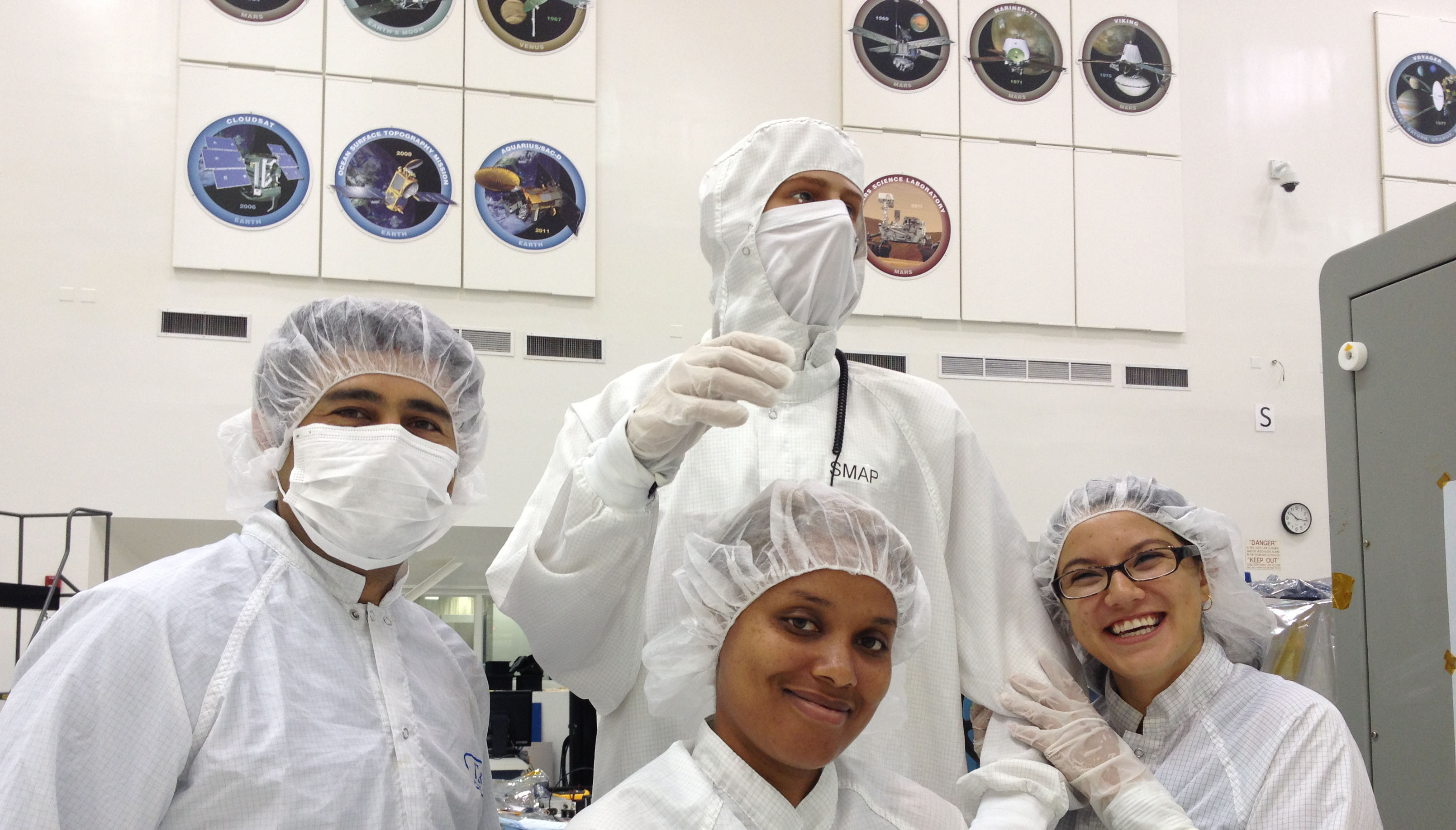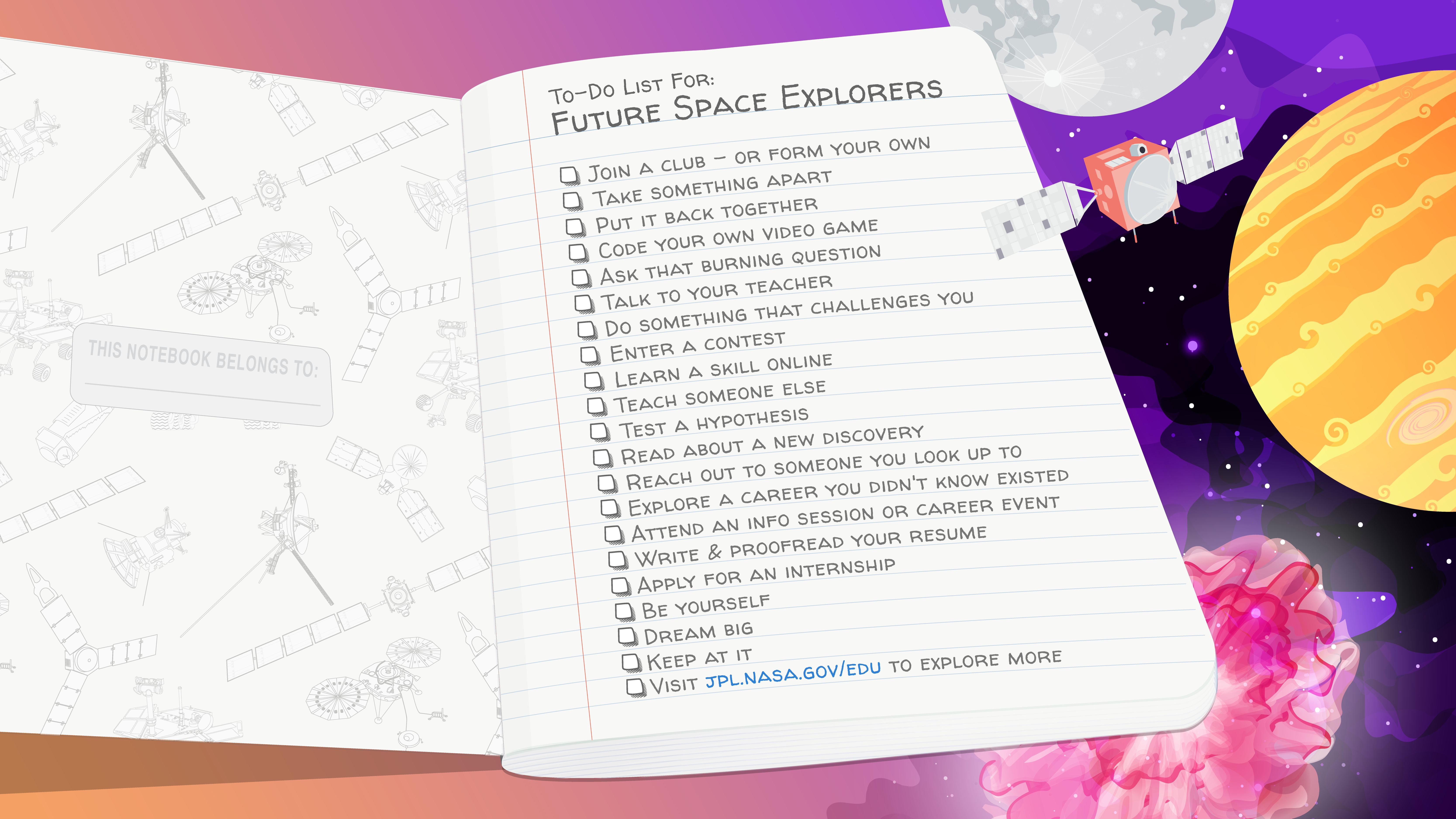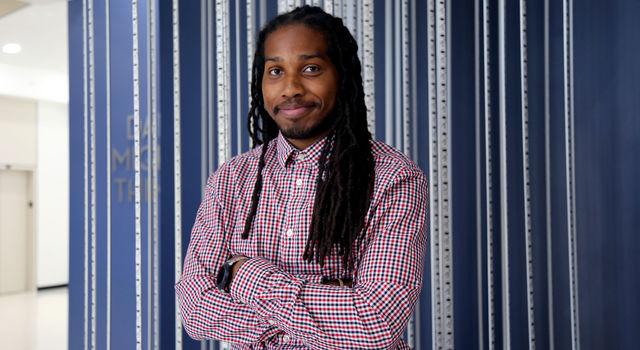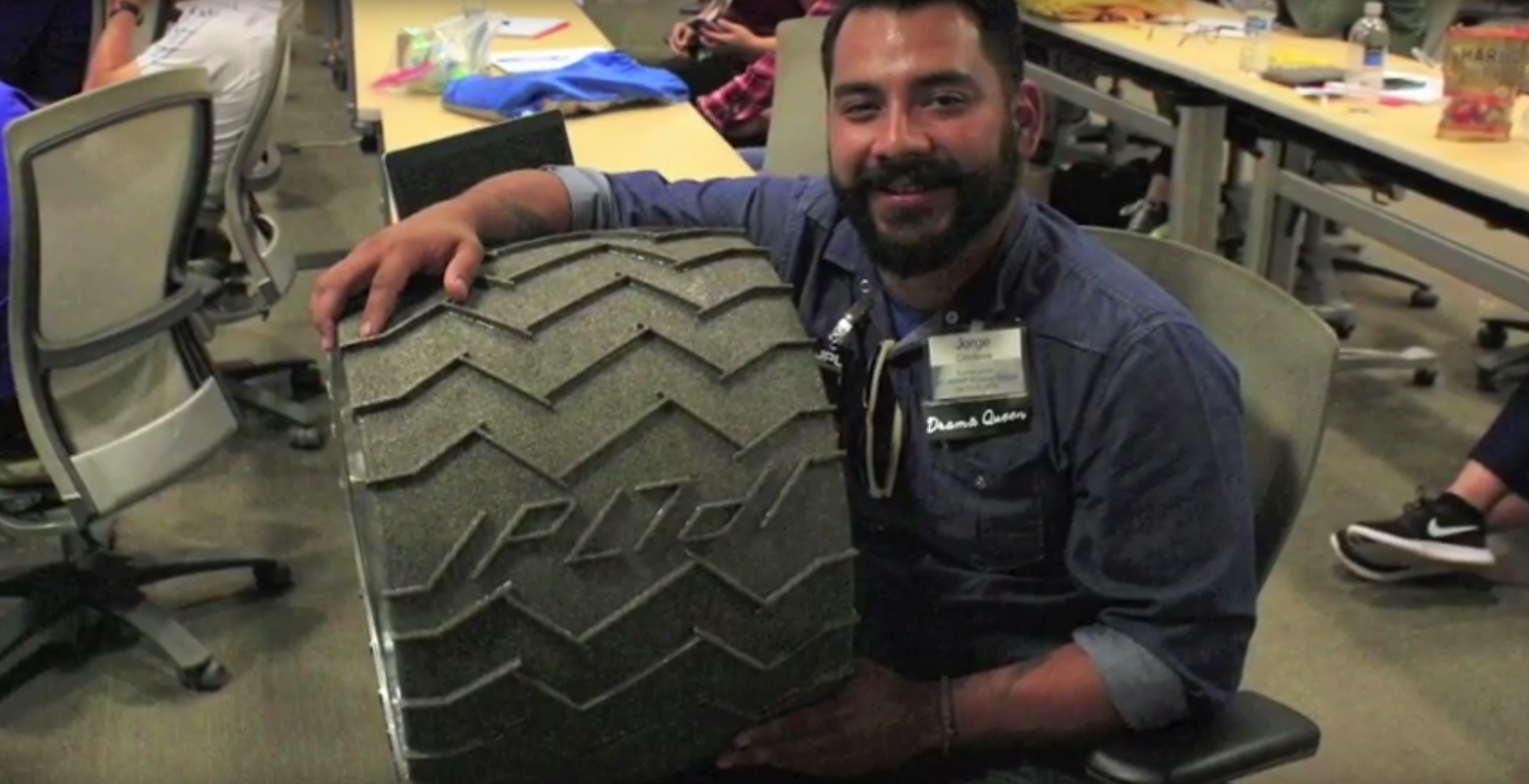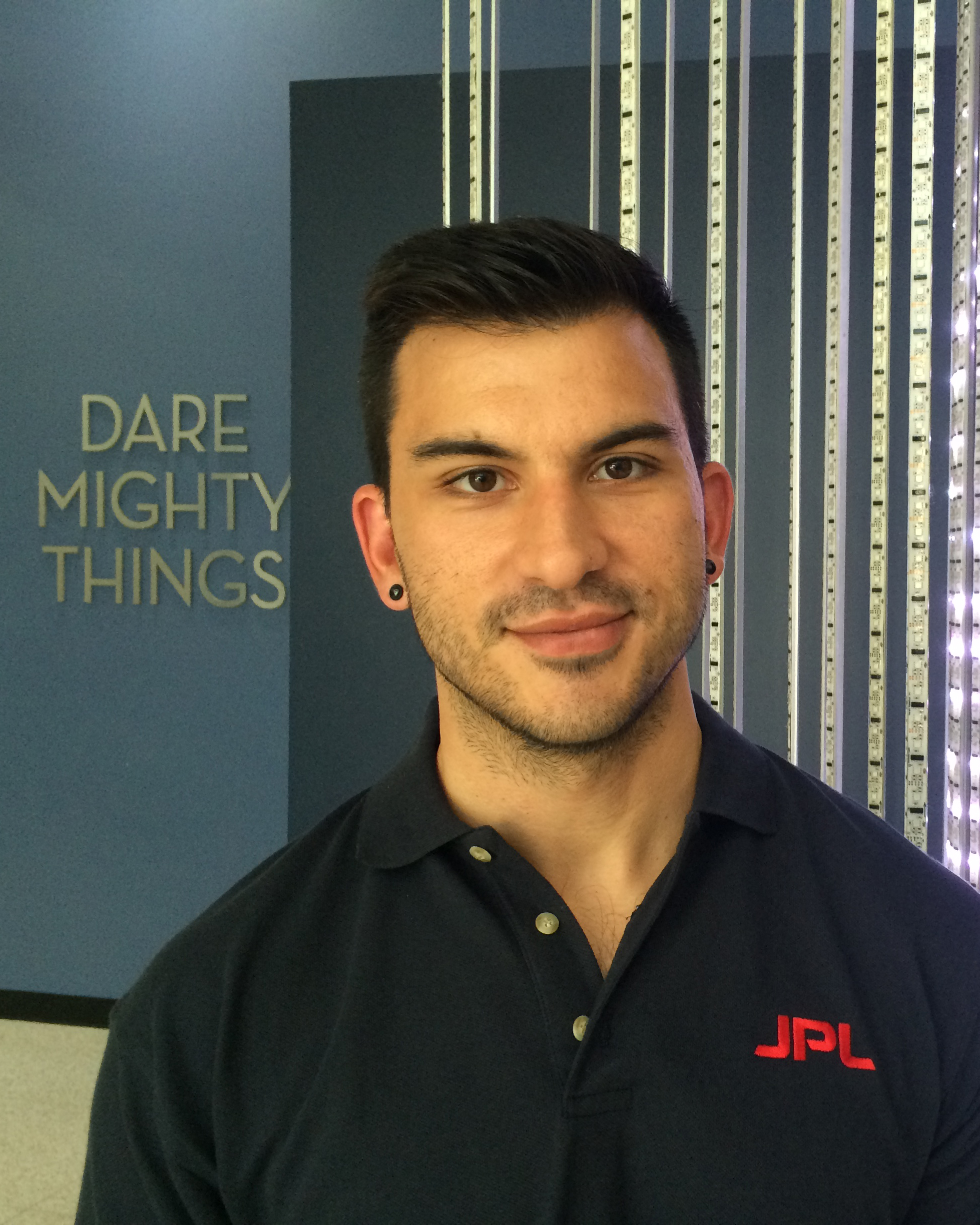Meet JPL Interns | July 31, 2023
Internship Program Powers Minds and Missions
A bi-coastal, multi-layered collaboration brings Ph.D. student interns to JPL for a unique opportunity to work on cutting-edge battery technology.
The last six months, interns Loleth Robinson and Jonah Wang spent their days in the Electrochemistry Lab at NASA’s Jet Propulsion Laboratory, testing, and analyzing novel power-storage cells that are pushing the frontiers of battery technology for space missions.
It’s the type of work that needs to be performed with one’s hands: chemicals mixed, cell casings assembled, wiring tinkered with, batteries cycled.
You can’t learn this in a classroom. At JPL, you can.
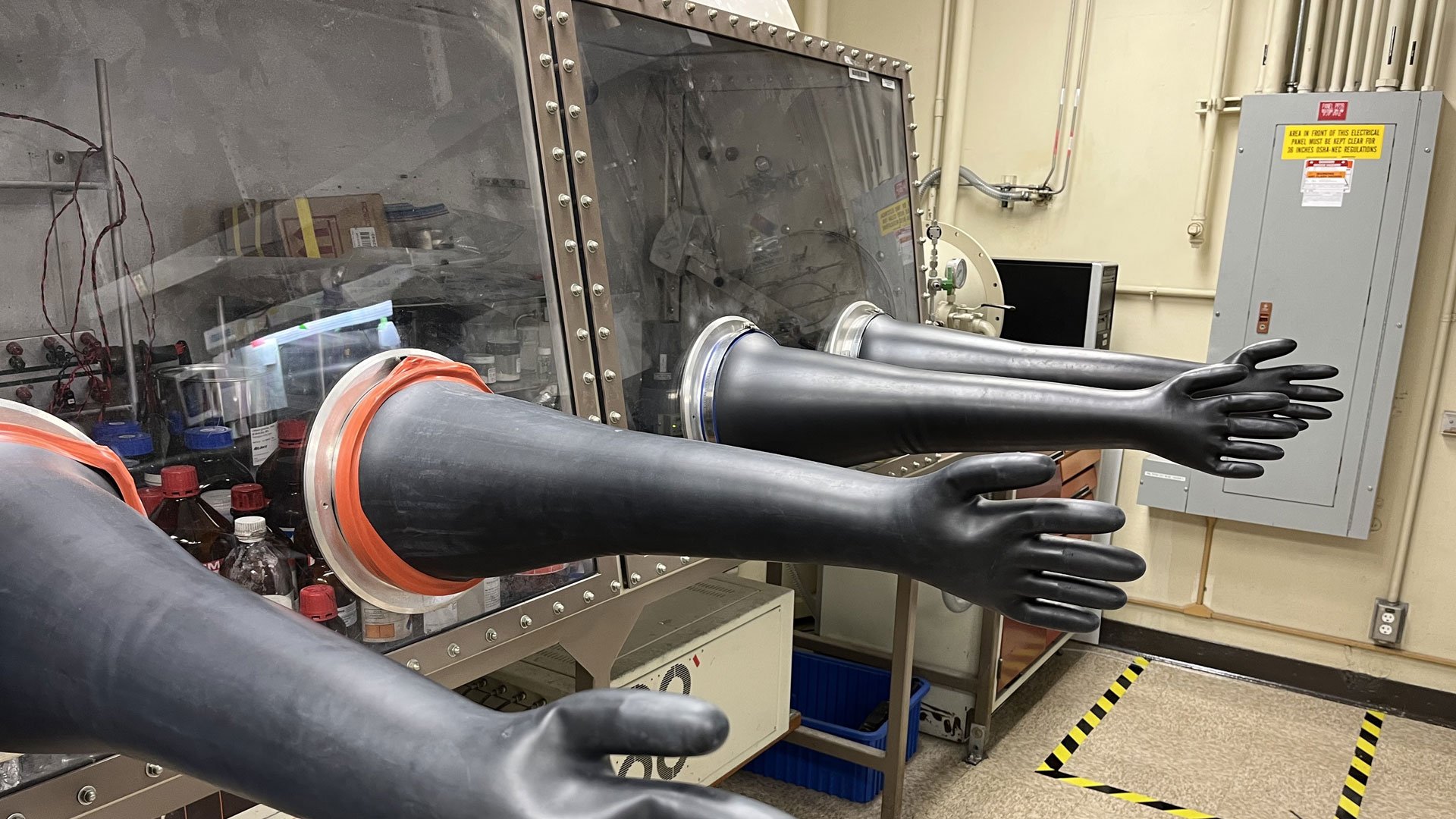
Gloves extend from a "glove box" where battery electrolytes are fabricated. Image credit: NASA/JPL-Caltech | + Expand image
The lab greets visitors with hands: four arm-length inflated rubber gloves extend as if to grab something. These gloves, inside out and ready to be fitted onto human arms, are connected to a “glove box” — a glass case filled with what looks like pharmaceutical bottles and the metal chemical canisters of a cartoon mad scientist.
It’s all very analog, retro even.
Beyond the glove boxes, a sinuous tangle of cables cascades over the edge of a desk, winding between battery cell prototypes and a potentiostat, an electronic device that measures the current and voltage cycled through the batteries. As electricity hums through this web of hardware, data pours into a series of computers, filling spreadsheets that wait to be analyzed.
For Robinson and Wang — both Ph.D. students at The City College of New York, studying chemical engineering with a concentration on the development of advanced battery technologies for space — getting their hands on this equipment in a NASA laboratory is as good as it gets.
“I don't think that I could have gotten a better opportunity anywhere else, working under brilliant scientists,” Wang says.
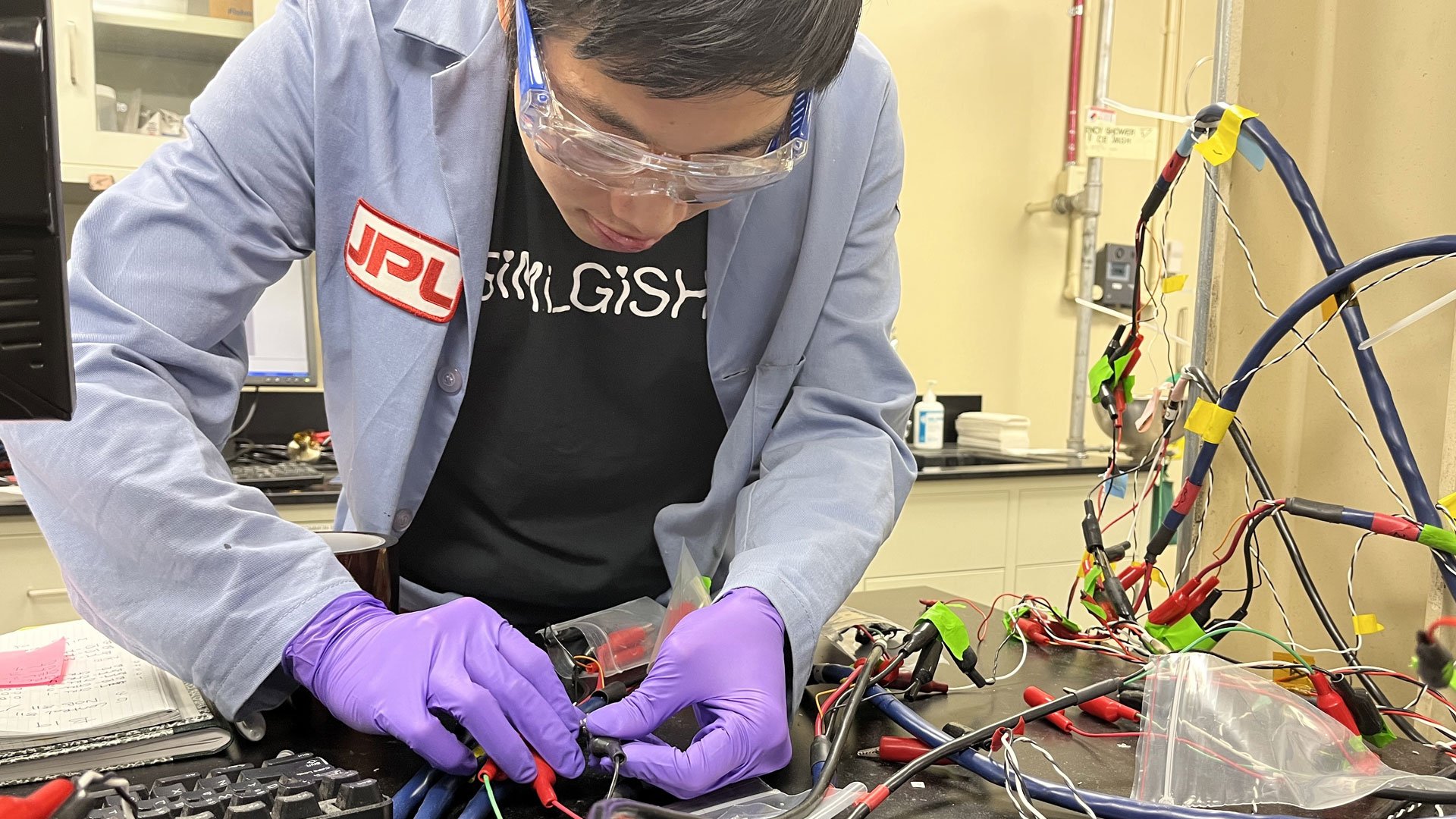
Wang connects battery cells to a potentiastat machine to cycle and collect data. Image credit: NASA/JPL-Caltech | + Expand image
That internship opportunity was the product of a collaboration that spans 3,000 miles and three organizations — JPL, CCNY, and NASA’s MIRO program.
Hands on Hardware, Minds on Missions
From its inception, this collaborative internship program between JPL, MIRO, and CCNY’s Center for Advanced Batteries for Space, now in its third year, sought to bring highly-capable Ph.D. students to JPL to put their minds to work solving problems that are of consequence to actual JPL missions and projects.
“I really wanted to make sure that the students had an opportunity to contribute to something meaningful,” says the interns’ JPL mentor, John-Paul Jones, who helped develop the JPL-MIRO-CCNY internship program. Jones is a battery technologist in the Electrochemical Research, Technology & Engineering Group. He is also the cognizant engineer facilitating the development of batteries for two projects — a lander designed to retrieve samples from Mars and a system of self-guided robots known as CADRE. “So we've tried to make sure that their projects align with something that's mission related.”
Robinson and Wang are focused on the Europa Lander and Venus Aerobot mission concepts — building batteries, performing testing, analyzing data, and meeting with their JPL colleagues to present and defend their work.
“They are right in the middle of cutting-edge battery research,” says Will West, the group supervisor of the Electrochemical Research, Technology, & Engineering, who oversees the interns' work with Jones. “They are being treated on these projects just like the other team members. They're doing experiments, generating data, and interpreting the data as a scientist would. Importantly, they must present and defend their work to the JPL team members. By doing so, they strengthen their scientific rigor and communication skills.”
While current battery technologies, primarily lithium-based, have advanced significantly in efficiency and performance in recent decades, they face certain constraints, including resource scarcity, safety concerns, and performance limitations. The batteries that Robinson and Wang are researching and testing could pave the way for improved energy-storing technologies that are more robust in extreme space-like conditions as well as safer and longer lasting even here on Earth, with potential applications ranging from electric vehicles to grid-scale energy storage.
And what does building and testing batteries actually look like?
First, the students synthesize mixtures of chemicals in the glove box to fabricate a novel battery electrolyte. (An electrolyte is the solution inside a battery that transfers ions between the positive and negative terminals.) They then build the battery cell using little metal cell casings that look like the battery you might find in your wristwatch. This all takes place inside the glove box and a vacuum chamber to avoid exposing dangerous chemicals to open air. Once the cell enclosure is complete, the cell can be removed from the glove box and connected to a set of wires that are fed into a potentiostat. This device measures the characteristics of the battery’s current and voltage and channels that information to a computer, where Robinson and Wang can analyze the data.
“It's amazing getting the hands-on experience,” Robinson says. “It’s an absolutely different experience from what I've seen in the industry and, of course, with just regular school research projects.”
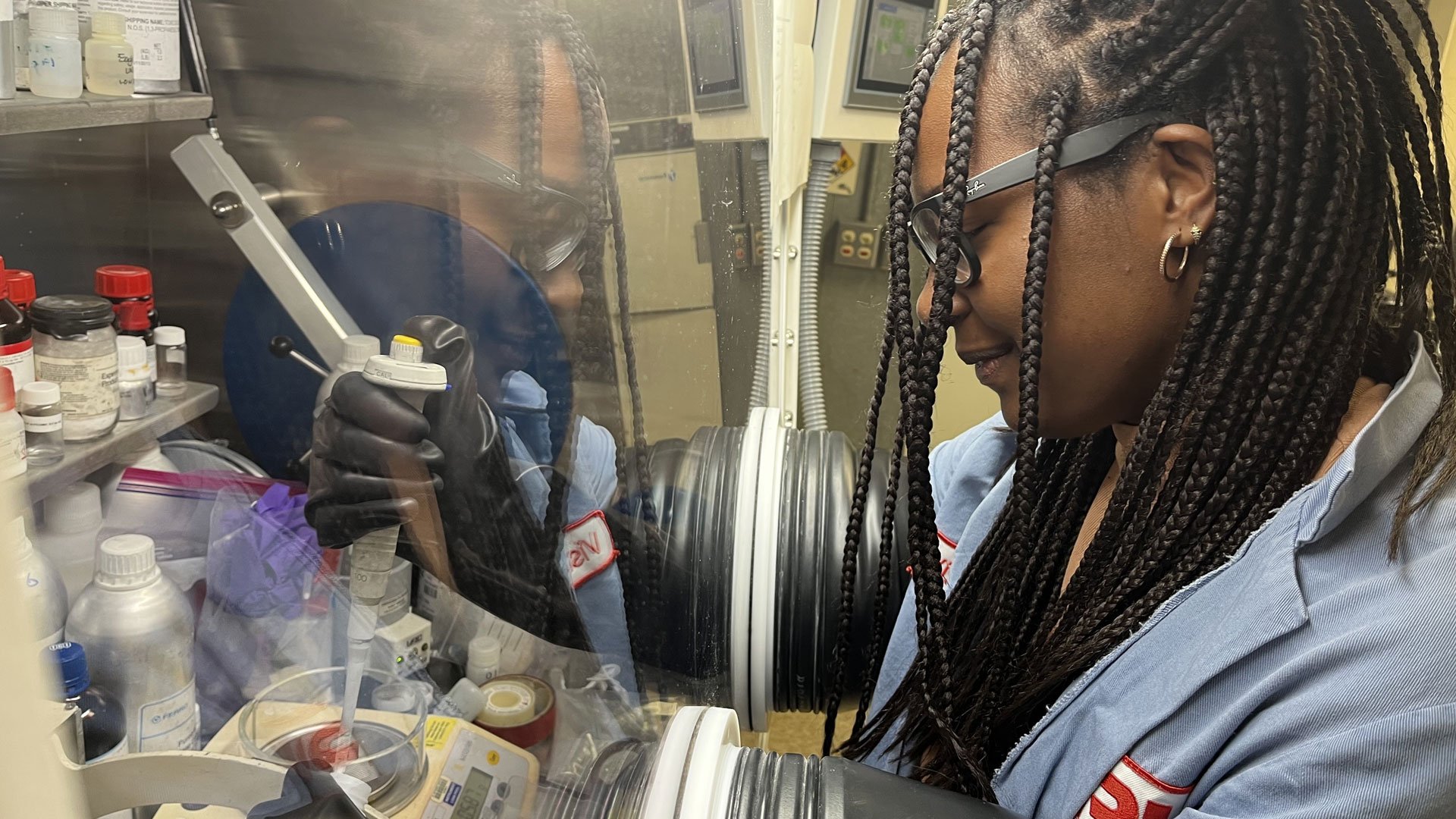
Robinson mixes chemicals to create a battery electrolyte formula for testing. Image credit: NASA/JPL-Caltech | + Expand image
Beyond building, testing, and analyzing battery cells, Robinson and Wang are also scouring related scientific literature to identify promising applications for future battery technologies.
For an internship, it’s no walk in the park.
“It's definitely a lot of hard work,” Wang says. “There's a really steep learning curve. I've learned a lot in a really short period of time. It's really amazing to be able to learn from actual research scientists who are trained in their fields.”
And while interns are not expected to have the depth of knowledge and experience that seasoned veterans do, Jones and West say they want to prepare the students for their paths in rigorous fields of research.
“Obviously we help them,” Jones says. “But I really want them to have some kind of ownership.”
Rob Messinger, the interns’ doctoral advisor, is an associate professor of chemical engineering at The City College of New York and the director of CCNY’s Center for Advanced Batteries for Space, a lab that focuses on upstream and emerging battery chemistries specifically geared toward powering spacecraft.
Messinger says the partnership with JPL has given the students in his program at CCNY an invaluable experience that he could not have created in the lab or classroom.
“It's difficult to even state or articulate the impact that this [internship program] has on CCNY students — scientifically, professionally, and personally,” Messinger says. “They have the opportunity to go into a NASA lab and directly work on NASA-relevant problems. But I think maybe even more valuable to the students is the opportunity to be mentored and trained by JPL scientists and engineers that have accumulated decades of experience.”
The Power Behind the Program
While the internship program is now humming along in its third year, only a few years ago it was just an idea.
In 2019, Jones received an email from Messinger out of the blue about collaborating on a rechargeable aluminum-graphite battery technology; his interest was piqued. As he read further, Jones saw the opportunity to create a unique internship program at JPL and jumped at the opportunity.
Jones had started at JPL in 2013 as an intern, eventually moving on to a Caltech postdoc stint before landing a full-time position back at the Laboratory. This was his chance to pay it forward.
Messinger thought that some of the research his doctoral students had been conducting in his lab at CCNY could be of interest to JPL.
“We had reason to believe, based on some preliminary data and prior work, that this particular aluminum-graphite technology could deliver high power at low temperatures,” Messinger says. “And so that was the initial hook to work with JPL — because those characteristics could potentially be useful for space.”
With Jones and group supervisor Will West on board at JPL, Messinger submitted a proposal to the MIRO funding opportunity made available by NASA’s Office of STEM Engagement. MIRO, which stands for MUREP Institutional Research Opportunity, was established to strengthen and develop the research capacity and infrastructure of minority-serving institutions in areas of direct alignment with NASA’s missions.
“I long had the idea of working with JPL,” Messinger says. “And then MIRO was the perfect funding source to enable this unique and strategic partnership.”
After some months of planning, Messinger and Jones launched the JPL-CCNY internship program, which was originally set to begin during the summer of 2020. The timeline, however, was derailed due to the pandemic, but after reworking their approach to accommodate remote collaboration, Jones and Messinger put their first intern, Brendan Hawkins, to work in the summer of 2021.
“It was really challenging to try to teach somebody how to build a battery in a lab from 3,000 miles away,” Jones says.
Fortunately, Hawkins was able to later come to JPL in person and gain that valuable hands-on experience for a few months at the end of the program. Since then, the program has hit the ground running, welcoming two other interns, Harrison Asare and Brian Chen, prior to Wang and Robinson in early 2023.
West says the program is a boon to all involved.
“The NASA MIRO program is funding the grad students, and they're working on projects that we assign here at JPL. We are so impressed with the huge contributions they’ve made to the projects,” West says. “So it's a huge win for JPL and NASA. And I would say certainly a win for the grad students to have this experience and a win for CCNY who is now getting these well-trained grad students back.”
Novel Energy Sources
For their part, the JPL staff say they have benefited immensely from the experience with their interns. West says Robinson and Wang’s infusion of ideas has been invaluable to his laboratory.
“I have been amazed by how quickly they acclimate to this high-intensity environment and contribute almost immediately,” West says. “They bring new ideas and fresh perspectives that have resulted in several journal manuscripts.”
Jones says collaborating with the interns has made him a better engineer.
“I think that the best way you learn something is to try to teach it to somebody else,” Jones says. “And I feel like I've learned an awful lot from this.”
Back in New York, the interns bring renewed energy and practical experience to the Center for Advanced Batteries for Space at CCNY.
“The collaboration with JPL has taken a lot of the research and development that we do here at CCNY, and it has given it life, it has given it applications that are exciting — it puts wind under our wings,” Messinger says.
Charged Up to Take Flight
For Robinson and Wang, neither knows exactly where their careers will take them, but both are certain this experience has opened doors.
“My mentors have tried to teach me how to be a better scientific researcher and how to really design and also do experiments,” Wang says. “That's something that might not show up on paper. Being able to say I worked at NASA is great, but I think actually learning the kind of stuff that it takes to do good experiments — that’s what’s really valuable.”
Robinson laughed recalling the moment she decided to pursue this course of study. She attended Messinger's presentation about his research program and never forgot his closing remarks.
“[Messinger] said the two coolest things to work on are dinosaurs or outer space, and dinosaurs are extinct. So take the second-best thing.”
Robinson, who was born in the U.S. but grew up primarily in Costa Rica, says she could have never imagined where that “second best thing” could take her — from a Ph.D. in New York City to working on spacecraft in Southern California to who-knows-what next.
“[Younger] me would have never thought that I'd be working in a NASA internship and doing a Ph.D. in chemical engineering,” Robinson says. “I couldn't even imagine that this was possible.”
The laboratory’s STEM internship and fellowship programs are managed by the JPL Education Office. Extending the NASA Office of STEM Engagement’s reach, JPL Education seeks to create the next generation of scientists, engineers, technologists and space explorers by supporting educators and bringing the excitement of NASA missions and science to learners of all ages.
The MUREP Institutional Research Opportunity, or MIRO, was established to strengthen and develop the research capacity and infrastructure of Minority Serving Institutions in areas of strategic importance and value to NASA’s mission and national priorities. MIRO works with 15 Minority Serving Institutions to offer awards that aim to support bright minds in STEM, while also enhancing the capability of institutions to perform NASA-related research and education.
The Minority University Research and Education Project, or MUREP, is a larger program through which the NASA Office of STEM Engagement engages underrepresented populations and minority-serving institutions through a wide variety of initiatives.
Career opportunities in STEM and beyond can be found online at jpl.jobs. Learn more about careers and life at JPL on LinkedIn and by following @nasajplcareers on Instagram.
TAGS: College, University, Internships, Opportunities, College Students, MSP, MIRO, MUREP, CCNY
Meet JPL Interns | August 22, 2016
Paving a Pathway to Diversity at NASA and JPL
Brandon Murphy’s family was well accustomed to his months-long jaunts to Virginia, Florida and Texas, the home of whichever NASA facility had offered him an internship that semester. Freshly inspired and equipped with new skills, yet a little homesick, Murphy always returned to North Carolina, where he’d lived and gone to school since the age of 12.
But when his fifth NASA internship rolled around in the spring of 2016, a dream opportunity at the agency’s Jet Propulsion Laboratory in Southern California, Murphy sat his family down and told them he wouldn’t be coming home this time.
“I packed up my entire house, put it on the back of a truck, and had them ship it here. Then I drove 36 hours from North Carolina to California in El Niño,” said Murphy, who at the time was still finishing up his master’s in computer science at North Carolina A&T State University.
A few years earlier, in the hope of improving his career prospects and “making a difference in the world,” Murphy had set his sights firmly on finding an internship – and eventually, a career – at NASA. When shortly after applying for an internship he got a call from the agency’s Wallops Flight Facility in Virginia, he couldn’t believe it. “At first I thought they were joking. I was like, you’re kidding me. You said NASA, right?”
He accepted almost immediately and spent the next four months developing visualizations and software for an airborne mapping instrument. It didn’t take long before he was hooked. “Ever since [that first internship], I applied at NASA every semester and some opportunities showed up that I didn’t even apply for,” said Murphy.
So when he got an internship offer from his top choice, JPL, with just months to go before earning his degree, Murphy decided to risk it all. “I just took a risk and said, I’m going to come to JPL, put my best foot forward and fingers crossed a full-time position opens up for me.”
His parents, military veterans who had tried to instill the values of minimizing risk were understandably worried. But six months after arriving at JPL, and on the eve of his sixth and final internship, Murphy got the position he was waiting for: a full-time gig in JPL’s cyber security group hunting for threats to the laboratory's systems and developing defenses against them.
Diversity in the Pipeline
Murphy’s story is exactly the kind Jenny Tieu is hoping to see more of at JPL. As one of several program coordinators in the laboratory’s Education Office, which brings hundreds of interns and fellows to JPL each year, Tieu focuses specifically on reaching underrepresented students, like Murphy, and bringing them into NASA’s pipeline – a cadre of workshops, internships and professional development designed to produce the next generation of scientists and engineers.
Internships are an important piece of that pipeline, providing hands-on experience and a foot in the door. Once in the pipeline, students are more likely to end up with a career at a NASA center. This year, for example, close to half of JPL’s new employees who recently graduated from college started at the laboratory as interns or fellows, a new record.
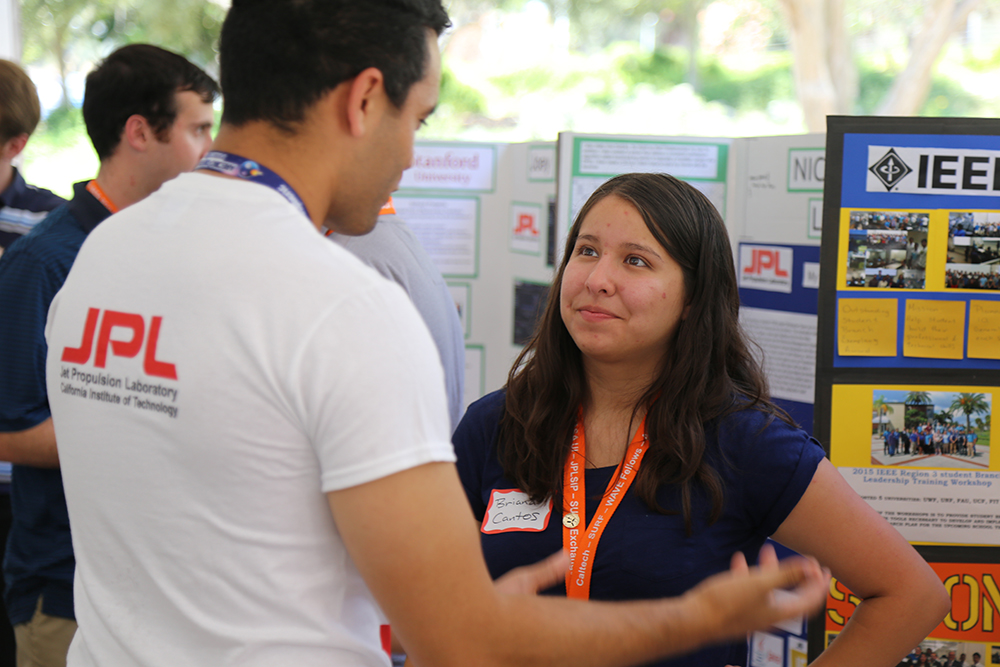
But more than just shape the workforce that will design the spacecraft of the future and explore new worlds, the pipeline is, “a great opportunity to cultivate a community of diverse thinkers and innovators who bring unique perspectives from a multitude of backgrounds,” said Tieu.
Promoting diversity in the pipeline involves a number of strategies by JPL and other NASA centers to reach out to schools that enroll high numbers of students who aren't typically well represented in science, technology, engineering and math (STEM), and partner with organizations working to get students involved in those fields.
One agency-wide program, the Minority University Research and Education Project, or MUREP, is what gave Murphy a chance to explore several careers at NASA – and helped him stand out.
"The combination of all the experiences and opportunities that Brandon had at different NASA centers really helped solidify his experience and make him a prime candidate for a full-time position,” said Tieu. “This is really the work of the MUREP community coming together as a team to provide opportunities and prepare students for the workforce.”
Creating diversity is not without its challenges, though. Perhaps the biggest hurdle is simply making sure students know that opportunities exist for them at NASA. The Education Office and its counterparts across the agency are constantly in search of new ways to reach out to students and encourage them to apply.
In his own way, Murphy is too. He says of his six internships, it was important for him to not only do well for himself, but also for his school, a Historically Black College and University (HBCU), so places like NASA would continue to seek out interns there. Already that attitude has paid off for at least one classmate who recently stopped Murphy in the school’s computer lab to thank him for setting a good example.
“He said, ‘I just wanted to thank you, because when [NASA Johnson Space Center] called to offer me an internship, they said that because of the work you did, they sought other students from A&T,’” said Murphy. “I was like, wow. He’s really going to get an opportunity to experience the great things that I experienced because I got there and put my best foot forward.”
When the Pipeline Ends?
The ultimate goal of the pipeline is to turn students who are interested in STEM into scientists and engineers. But what happens once the former interns are hired comes down to efforts at each NASA center to wrap them into the unique culture.
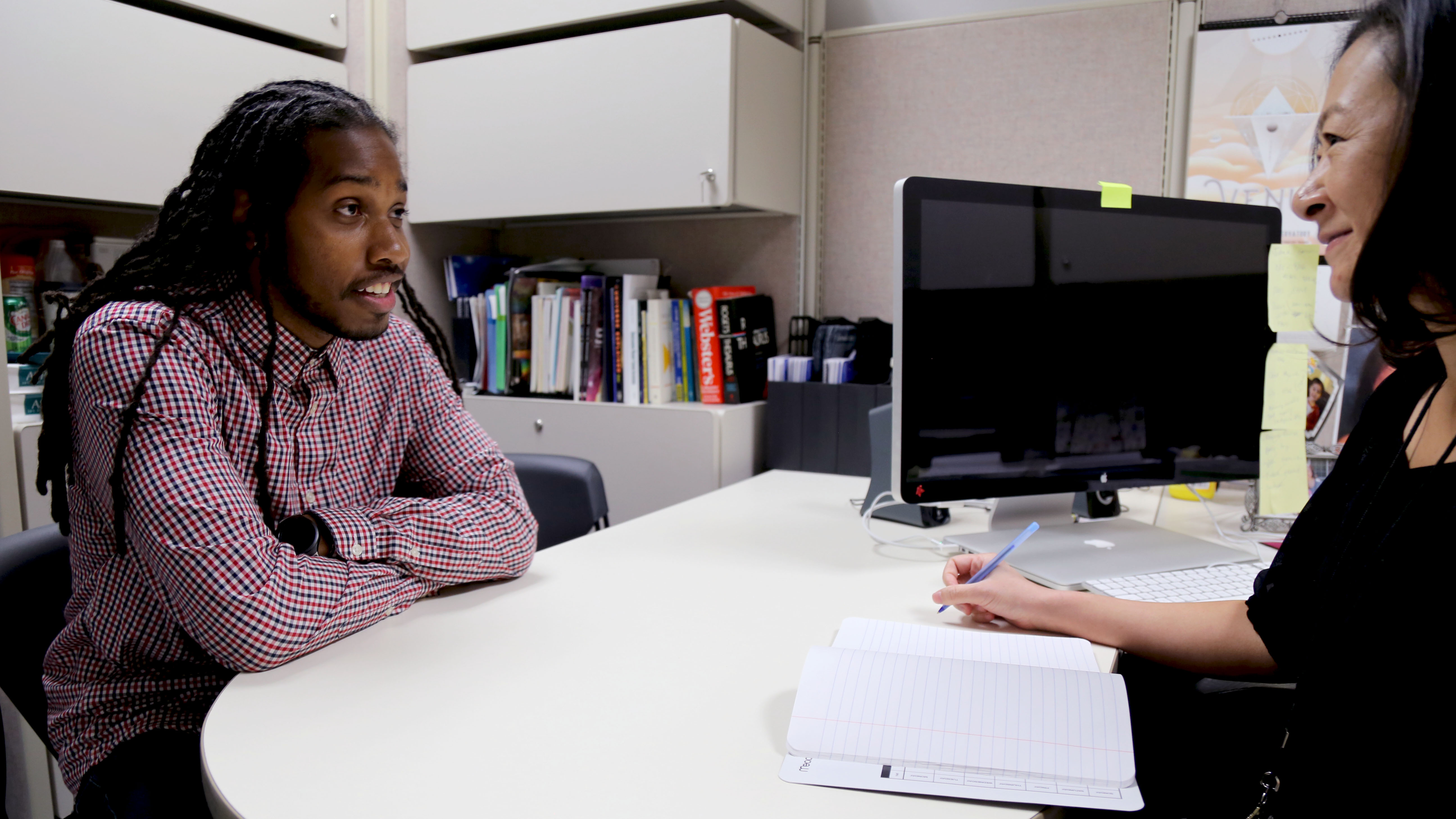
In recent years, JPL has built a strong supportive community for employees who are new to the professional world, offering mentorship and networking opportunities that help with retention. Meanwhile, Tieu and others in the Education Office stay connected with former interns and provide them with resources and help from support groups.
So far, for Murphy, who just started his full-time job last week, it feels like everything fits just right. “This is the place that I really feel comfortable in the work that I’m doing and I see the overall goal, the bigger picture,” said Murphy. “If this is how work is going to be for the rest of my career, I could get used to this.”
His parents have gotten used to it, too. “My mom’s really spilling it all out on Facebook, so I know she’s proud of me,” said Murphy.
Explore our Intern page to learn more about opportunities at JPL and NASA, and apply.
See stories and photos from JPL interns and fellows:
TAGS: Internships, Fellowships, Programs, MUREP, NASA, Black History Month
Edu News | July 18, 2016
Highlights from NASA's Educator Institute at JPL
Last week, 50 university students studying to become K-12 science, technology, engineering and math teachers attended an educator institute at NASA's Jet Propulsion Laboratory as part of the agency's Minority University Research and Education Project, or MUREP. The institute is designed to provide pre-service teachers from minority-serving institutions with NASA resources and connections.
During the week, participants met with science and mission team leaders to discuss topics including construction of the Mars rover Curiosity, techniques used to discover planets outside our solar system, and future plans to study Jupiter's moon Europa. They also had the opportunity to tour facilities such as the Mars Yard, where Mars mission engineers test rover maneuvers, and mission control, the national historic landmark where teams monitor the nail-biting landings of such rovers.
JPL education specialists walked participants through hands-on lessons and activities from the JPL Education website and demonstrated how the standards-based activities could be used in the classroom. Among the activities, participants took on a number of engineering design challenges, constructing rovers and planetary landers, and did inquiry-based planning to develop solutions for climate and water issues on Earth.
See a collection of photos and videos from the week in the highlight reel above and using the hashtag #NASAMEI2016 on Twitter.
To learn more about the MUREP educator institute, visit the NASA Educator Professional Development Collaborative website.
More information about NASA's Minority Research and Education Project and related programs, can be found, here.





